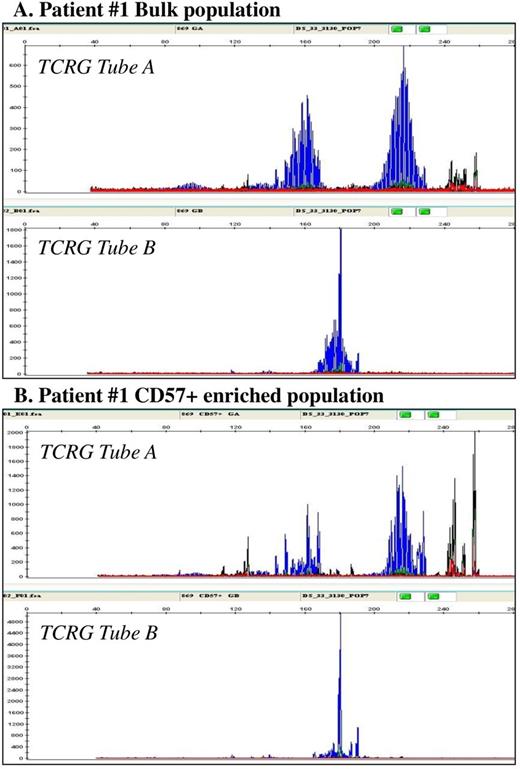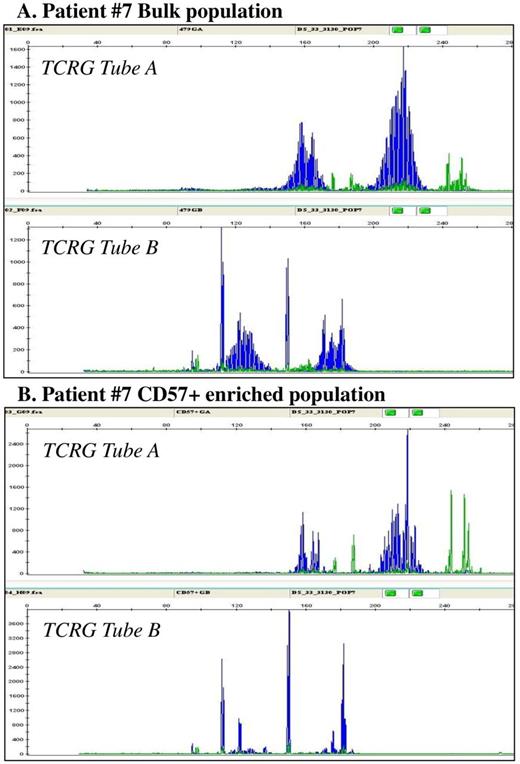Abstract
Large granular lymphocytic leukemia (T-LGL) characterized by steady increase in large granular lymphocyte counts over 2*109/l in peripheral blood. T-LGL frequently manifested with splenomegaly, neutropenia, anemia, lymphocytosis, and complicated by infectious diseases. T-LGL cells have mature, post-thymic immune phenotype expressing CD3+,TCRab, CD8+, CD57+ etc.
In up to 1/3 of cases T-LGL is combined with autoimmune diseases like rheumatoid arthritis (RA) and could be misdiagnosed asFelty'ssyndrome. Differential diagnosis requiresclonalitytesting. However admixture of polyclonal large granular lymphocytes may compromise PCR sensitivity and decrease the diagnostic value of the test. CD57 + is a typical, but not strictly specific marker of T-LGL cells. Therefore, enrichment in CD57+ cells may circumvent PCR sensitivity issues.
This study aimed to assess the possibility and feasibility of clonal assay performed on a selected CD57+ population of peripheral blood lymphocytes in patients with T-LGL for differential diagnosis/verification.
The study included 13 patients with RA and assumed T-LGL diagnosis. CD57+ lymphocytes were isolated by means ofimmunomagneticselection onMiltenyiBiotecbeads.T-cellclonalitywas assessed by T-cell receptor gamma chain TCRG (VG - JG) gene rearrangements using multiplex PCR with BIOMED-2 primer system and subsequent Gene-Scan analysis.
Polyclonal pattern in bulk lymphocyte population was observed in patients ## 1-3 (Table 1). CD57+ enrichment allowed to determineclonalityand approve T-LGL diagnosis for patient #1 (Figure1). Due to the lack ofclonalityin CD57+ population T-LGL diagnosis was excluded for patient #2. Patient #3 showedoligoclonalpattern in CD57+ enriched population.
Bulk lymphocyte population in 5 of 13 patients was monoclonal. After CD57+ enrichment 3 of these 5 patients showed identical monoclonal pattern. Other two patients aquiredadditional peaks (Figure2). In 3 of 13 patients monoclonal peak exceeded the polyclonal background less than 3 times and was interpreted as doubtful monoclonal result. After CD57+ enrichment oligoclonalpattern was detected in these cases. 2 of 13 patients preserved oligoclonalpattern for both bulk and CD57+ enriched lymphocyte populations.
CD57+ selection was supportive for diagnostic procedure in 2 cases so far. Based on CD57+ population analysis in one case T-LGL diagnosis was approved while in other excluded. All other included cases gained no benefit from CD57+ enrichment. Frequentoligoclonalpattern in T-LGL may reflect restriction of TCR repertoire of effector cells.
We conclude that CD57+ enrichment forclonalitystudies in T-LGL is of limited value for diagnostic procedure in clinical practice. At least at the present level of understanding of T-LGL pathogenesis and reactive lymphocyte populations involved.
Results of TCRGclonalityassessment in patients with RA and assumed T-LGL diagnosis for bulk and CD57+ enriched lymphocyte population.
Results of TCRGclonalityassessment in patients with RA and assumed T-LGL diagnosis for bulk and CD57+ enriched lymphocyte population.
Results of TCRGclonalityassessment for patient #1 with polyclonal pattern in bulk population (A) and monoclonal pattern in CD57+ enriched lymphocyte population (B).
Results of TCRGclonalityassessment for patient #1 with polyclonal pattern in bulk population (A) and monoclonal pattern in CD57+ enriched lymphocyte population (B).
Results of TCRGclonalityassessment for patient #7 with monoclonal pattern in bulk population (A) andoligoclonalpattern in CD57+ enriched lymphocyte population (B).
Results of TCRGclonalityassessment for patient #7 with monoclonal pattern in bulk population (A) andoligoclonalpattern in CD57+ enriched lymphocyte population (B).
No relevant conflicts of interest to declare.
Author notes
Asterisk with author names denotes non-ASH members.




